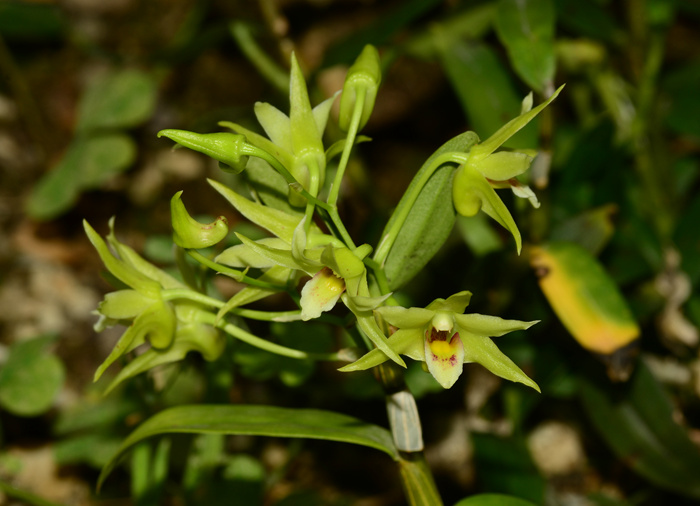- Scientific Name: Dendrobium catenatum Lindl.
- Ref: Gen. Sp. Orchid. Pl.:84. 1830
- Synonyms:
- Callista stricklandiana (Rchb.f.) Kuntze
- Dendrobium funiushanense T.B.Chao, Z.X.Chen & Z.K.Chen
- D. huoshanense Z.Z.Tang & S.J.Cheng
- D. officinale Kimura & Migo
- D. pere-fauriei Hayata
- D. stricklandianum Rchb.f.
- D. tosaense Makino
- D. tosaense var. chingshuishanianum S.S.Ying
- D. tosaense var. pere-fauriei (Hayata) Masam.
- English Common Name: chained dendrobium
- Chinese Common Name: 铁皮石斛 tiěpí shíhú, 黄石斛 huáng∙shíhú
- Family: Orchidaceae
- Genus: Dendrobium
- Distribution: Lithophytic in moderately damp mountains; ca. 1600 m. SW Anhui (Dabie Shan), W Fujian (Ninghua), NW Guangxi (Tian’e), Sichuan, Taiwan, SE Yunnan, E Zhejiang (Tiantai, Xianju, Yinxian) [Japan].
- Photo: 05/08/2016, Lishui, Zhejiang
Stems erect or pendulous, cylindric, 3-35(-60) cm, slender, 2-7 mm in diam., sometimes to 18 mm in diam. above base, unbranched, with many nodes, internodes (0.3-)1.3-4 cm, pale yellowish green, sometimes with pale purplish red dots, pale yellow when dry. Leaves often 2-5 along upper part of stem, ligulate-oblong or oblong-lanceolate, 3-21 × 0.5-1.5 cm, papery, base slightly oblique and decurrent into clasping sheaths, margin and midvein often tinged with pale purple, apex obtuse and ± hooked, subacute, or slightly unequally bilobed; leaf sheath often with purple spots, upper margin separate from stem and open when old, with a deep green split. Inflorescences 1-3 from leafy or old leafless stems, (1-)3-8-flowered; peduncle 2-10 mm; rachis upcurved, 2-4 cm; basal sheaths 1-4, ovate-lanceolate, 3-4 mm, papery, apex acute; floral bracts pale white, sometimes tinged with chestnut, narrowly lanceolate or ovate, 3-7 mm, dry, membranous, apex obtuse or acute. Pedicel and ovary yellowish green, 2-4 cm. Flowers spreading; sepals and petals yellowish green, pale yellowish white, or white, often turning creamy yellow later, mentum white tinged yellowish green, lip white or pale yellow, with a reddish or reddish brown transverse mark, with a green or yellow basal callus, with purplish red stripes on both sides below middle, disk with a purplish red transverse spot above middle, column greenish white or yellowish green, with a purple spot on each side at apex, foot yellowish green with purplish red stripes, middle with an eggplant-purple spot, anther cap cream-colored, sometimes with a purple tip. Dorsal sepal ovate-oblong or ovate-lanceolate, 12-17 × 4-7 mm, 3-5-veined, acute or slightly obtuse; lateral sepals obliquely ovate-triangular or falcate-lanceolate, ca. as long as dorsal sepal, 10-13 mm wide at base, 3-5-veined, apex obtuse or acute; mentum subrectangular to conic, 5-7 × to ca. 6 mm, rounded. Petals oblong or ovate-oblong, 12-16 × 4-7(or more) mm, 5-7-veined, apex obtuse or acute; lip elliptic-rhombic, broadly ovate, or ovate-lanceolate, 13-17 × 8-11(or more) mm, slightly cuneate at base, entire or obscurely 3-lobed, middle recurved, margin ± undulate, apex acute; disk densely finely papillate-hairy or pilose, medially with a low thickening, terminating at ca. middle. Column 2-4 mm, foot 0.7-1 cm, upper part with lax purple-tipped hairs, apex purplish red, strongly thickened at point of attachment to lip; anther cap narrowly subelliptic, ovate-triangular, or ovate-conic, 1.5-3 mm, nearly glabrous, apex subacute and bilobed, lobes sharply toothed. (Flora of China)
